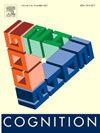好奇的选择婴儿每时每刻的信息取样都受其探索历史的驱动。
IF 2.8
1区 心理学
Q1 PSYCHOLOGY, EXPERIMENTAL
引用次数: 0
摘要
婴儿对周围世界的探索是基于他们内在的好奇心。然而,这种好奇心驱动的探索行为背后的认知机制在很大程度上仍是未知的。在这里,婴儿可以自由探索两个新的类别,通过固定注视电脑屏幕上两个相关区域中的任何一个来触发一个类别中的新范例。这种凝视条件设计使我们能够区分探索(从一个类别切换到另一个类别)和利用(连续触发同一类别中的范例)。来自 10 到 12 个月大婴儿(68 人)的数据表明,每时每刻的取样选择都不是随机的,而是受婴儿探索历史的引导。自我生成的序列分为三组,即短暂但具有探索性的取样模式、较长的探索性取样模式和总体上较为均衡的取样模式。贝叶斯分层二项回归模型表明,在不同的序列模式中,婴儿较长的触发时间、较短的注视时间和较多的视线转移与逐次试验决定脱离利用一个类别并进行探索性转换有关,尤其是在连续观看高度相似的刺激物之后。这些发现为研究婴儿好奇心驱动的探索提供了新的视角,并为今后研究个体差异铺平了道路。本文章由计算机程序翻译,如有差异,请以英文原文为准。
Curious Choices: Infants' moment-to-moment information sampling is driven by their exploration history
Infants explore the world around them based on their intrinsically motivated curiosity. However, the cognitive mechanisms underlying such curiosity-driven exploratory behaviour remain largely unknown. Here, infants could freely explore two novel categories, triggering a new exemplar from a category by fixating on either of the two associated areas on a computer screen. This gaze-contingent design enabled us to distinguish between exploration – switching from one category to another – and exploitation – consecutively triggering exemplars from the same category. Data from 10 to 12-month-old infants (N = 68) indicated that moment-to-moment sampling choices were non-random but guided by the infants' exploration history. Self-generated sequences grouped into three clusters of brief yet explorative, longer exploitative, and overall more balanced sampling patterns. Bayesian hierarchical binomial regression models indicated that across sequence patterns, infants' longer trigger time, shorter looking time, and more gaze-shifting were associated with trial-by-trial decisions to disengage from exploiting one category and making an exploratory switch, especially after consecutively viewed stimuli of high similarity. These findings offer novel insights into infants' curiosity-driven exploration and pave the way for future investigations, also regarding individual differences.
求助全文
通过发布文献求助,成功后即可免费获取论文全文。
去求助
来源期刊

Cognition
PSYCHOLOGY, EXPERIMENTAL-
CiteScore
6.40
自引率
5.90%
发文量
283
期刊介绍:
Cognition is an international journal that publishes theoretical and experimental papers on the study of the mind. It covers a wide variety of subjects concerning all the different aspects of cognition, ranging from biological and experimental studies to formal analysis. Contributions from the fields of psychology, neuroscience, linguistics, computer science, mathematics, ethology and philosophy are welcome in this journal provided that they have some bearing on the functioning of the mind. In addition, the journal serves as a forum for discussion of social and political aspects of cognitive science.
 求助内容:
求助内容: 应助结果提醒方式:
应助结果提醒方式:


